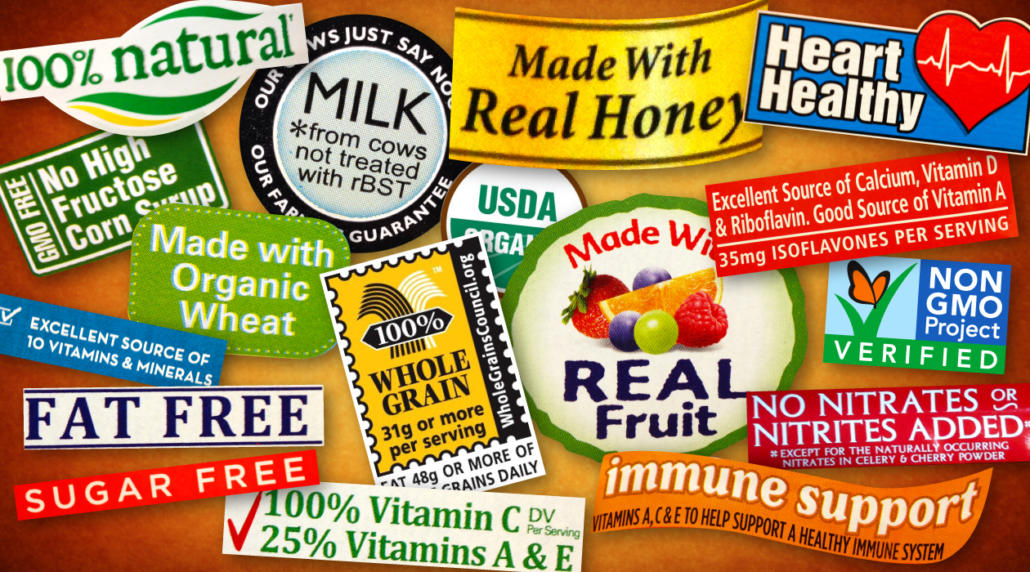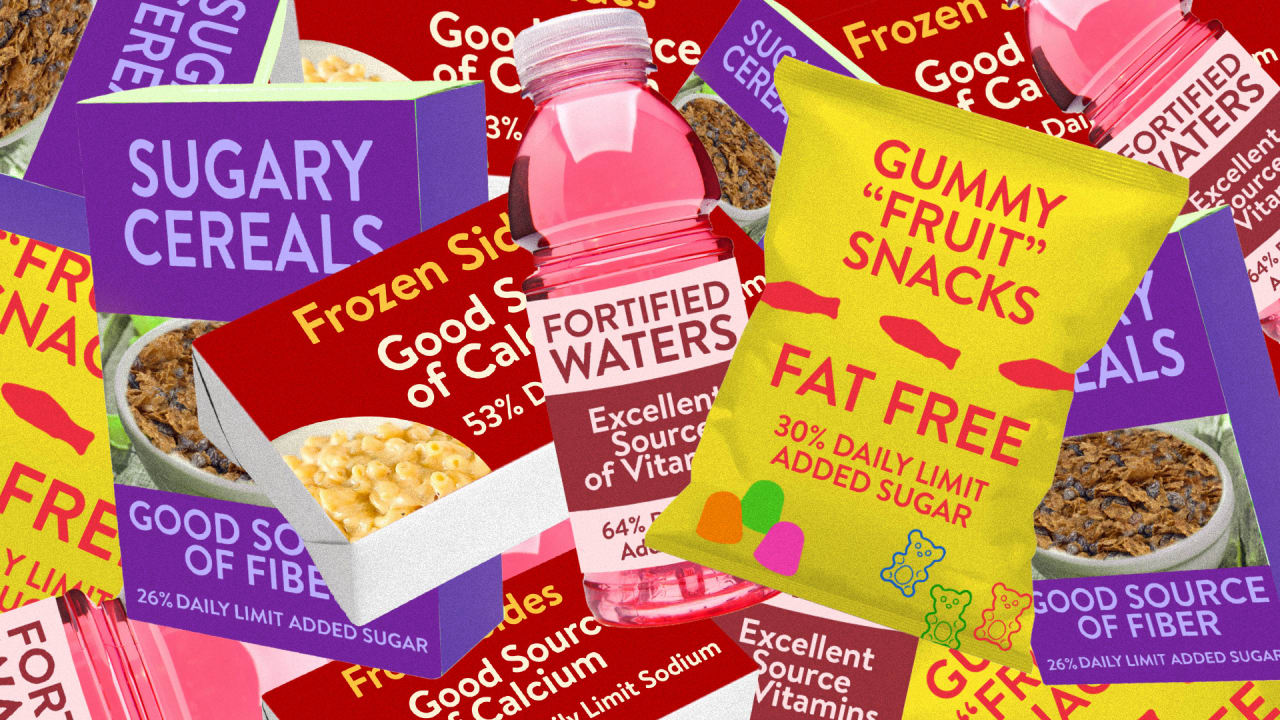44 misleading food labels canada
Method of production claims on food labels - Canadian Food Inspection ... The National standard of Canada for Voluntary labelling and advertising of foods that are and are not products of genetic engineering (Standard), developed by the Canadian General Standards Board, provides criteria for making voluntary labelling and advertising claims that identify foods sold in Canada that are or are not products of genetic engineering. It includes detailed information including criteria for claims on both single and multi-ingredient foods, verification, and examples of claims. Top five misleading food labels - BC SPCA The Canadian Food Inspection Agency (CFIA) is responsible for labelling requirements of food in Canada, and they set guidelines for what claims and statements can be used. While guidelines are in place, there is still room for consumers to be misled. Here are some common food labels that might not mean what you think. 1. Natural claims
15-point plan against misleading labelling and advertising - foodwatch The problem: Currently, food companies are allowed to hide the nutritional values of their products in the fine print on the back of the packaging. On front-of-pack GDA labels (for "Guideline Daily Amounts"), manufacturers use unrealistic portion sizes and misleading target guidelines to make the product look healthier than it actually is.

Misleading food labels canada
Food Fraud Is Real. Here's How To Detect Mislabeled Foods. C onfusing Labels That May Unintentionally Mislead In 2016, the FDA published new rules for nutrition facts labels for packaged foods. As mentioned, manufacturers with $10 million or more in annual sales switched by Jan. 1, 2020 ― manufacturers with less than $10 million in annual food sales have until Jan. 1, 2021, to comply. Canadian technology fights misleading food labelling | CBC News In a recent scandal in Europe, meatballs and ground beef ravioli were found to be made from horse meat, not beef. The CBLN checked Canadian hamburger patties and found there was not horse meat in... Health Canada answers your questions about food labels, allergens and ... Requirements for labelling of food sold in Canada are set out in the Food and Drugs Act and the Food and Drug Regulations. The intent of the labelling regulations is to provide Canadians with the information they need to make informed choices about the foods they eat. Health Canada works closely with the Canadian Food Inspection Agency (CFIA) on issues related to food labelling, including the declaration of food allergens on the labels of prepackaged foods. The CFIA is responsible for all ...
Misleading food labels canada. In Pictures: 29 Foods With "Health Claims" That Are Deceiving You And ... A. It's a little scary that food companies can put deceptive labels on foods we already know are unhealthy. I've first-hand see people say "oh, look, it's all natural!" and then never question the food from then on out.-Agreed. B. The whole "all natural thing." People think if a label says it's natural, it's fine to eat. Canada Product Labeling Standards Requirements | QIMA Minimum mandatory labeling requirements for all types of products are as follows: Product Identity: common or generic name, or definition of product function. Net Quantity: displayed in metric units of volume for liquids and gases, or weight for solids. Misleading Food Labels Misleading food labels could put you at risk. Food producers often use labels as a marketing tool & you might not be getting what you think Health Claims - Canada.ca For example, the label, packaging or advertisement of a food must not give the impression that the food is for use in a weight reduction diet, unless the food is one of the foods listed in Subsection B.24.003(3) of the Food and Drug Regulations (FDR) and meets the requirements set out in Division 24 for those foods, including the requirement for the statement "Useful in weight reduction only as part of an energy-reduced diet".
Food advertising requirements - Canadian Food Inspection Agency Advertisements directly or indirectly promote the sale of foods through broadcast (for example, television or radio), the internet, or in print. In general, mandatory information or claims that are acceptable on a food label may also be used to advertise that food. Unacceptable label information is generally also not acceptable in advertising. Nutrition Labelling and Marketing in Canada Food package labels can contain multiple forms of nutrition information to which consumers are exposed when making decisions: ingredient lists, nutrient content and health claims, functional food claims, front of package symbols and logos, how the food was produced and distributed (e.g., organic, fair trade), industry marketing, and product photos. In a study by our lab, we found that more ... Packaging and labelling requirements - Competition Bureau Canada If you sell a prepackaged non-food product in Canada, you must ensure the package label meets the requirements of the Consumer Packaging and Labelling Act and Regulations. ... The need to ensure that all information on the label is accurate and not misleading; 1. Mandatory information. The label on a prepackaged product must include three key ... 8 misleading food marketing labels | AGDAILY This label is misleading because many consumers assume it means the food is healthier, safer and/or better for the environment when that's not necessarily the case. 4. Non-GMO Many consumers assume that if a product has a non-GMO label, it must be superior to a similar product next to it without that label, but that's not true at all.
Why Lawsuits Over 'Misleading' Food Labels Are Surging - The New York Times The misleading labels, the plaintiffs say, seek to profit off consumers' growing interest in clean eating, animal welfare and environmentally friendly agriculture — but without making meaningful... Canadian nutrition label claims often wildly misleading, tests show ... Canadian nutrition label claims often wildly misleading, tests show. OTTAWA - Some of the world's biggest food brands and leading organic labels have understated the amount of bad nutrients ... misleading food labels - HuffPost The food industry is notoriously misleading, undeniably corrupt, and has the one of the largest revenue streams in the world. Coca Cola has lobbyists in Washington, and the meat industry makes no bones about being in bed with the political process. Despite our leaps and bounds in medical science, why can't we effectively tackle the obesity epidemic? PDF Voluntary labelling and advertising of foods that are and are not ... Food label and advertising claims pertaining to the use or non-use of genetic engineering are permissible in Canada, provided such claims are truthful; not misleading; not deceptive; not likely to create an erroneous impression of a food's character, value, composition, merit or safety; and in compliance with all other regulatory requirements set
Food labelling in Canada - Wikipedia According to the Canadian Government, the following foods are exempted from being required to have a food label: Fresh fruits and vegetables Raw meat and poultry Raw seafood Foods prepared or processed in store (i.e. bakery items, salads) Foods that contain very few nutrients (i.e. tea, coffee) Alcoholic beverages
General principles for labelling and advertising - Canadian Food ... It is prohibited for a person to manufacture, prepare, package, label, sell, import or advertise a food commodity in a manner that is false, misleading or deceptive or is likely to create an erroneous impression regarding its character, quality, value, quantity, composition, merit, safety or origin or the method of its manufacture or preparation.
10 misleading food product labels in Canada | CBC News Marketplace contacted a doctor who specializes in healthy eating, Dr. Yoni Freedhoff, to examine a number of claims found on the labelling of food products and created a Top 10 list of lousy...
Home - Competition Bureau Canada Get information about false and misleading advertising, contests, performance claims, multi-level marketing and telemarketing. Labelling Find the requirements for labelling of prepackaged (non-food) consumer products and textiles, and marking of precious metals. Fraud and scams View our tips on how to recognize and report fraud and scams.
Natural Label Claims - Canadian Food Business In addition, Canadian consumers tend to be less litigious than their American counterparts. However, this is not to say that Canadian food manufacturers are immune from reproach in connection with labels. In Canada, mislabeled food can be subject to a Corrective Action Report and/or a recall.
Weekly Topic: Editorial - Misleading food labeling Companies have realized there is scant danger from mislabeling, evidenced by the skyrocketing number of food labeling cases in litigation (19 in 2008, 425 active between 2015 and 2016) as consumers and competitors attempt to enforce guidelines in court. While cases are in litigation, products often remain on the shelves. Changes are called for.
Canada - Labeling/Marking Requirements - International Trade Administration Innovation, Science, and Economic Development Canada is charged with ensuring that any claims about a product being "environmentally friendly" are accurate and in compliance with relevant legislation. In general, environmental claims that are ambiguous, misleading or irrelevant, or that cannot be substantiated should not be used.
10 misleading food product labels in Canada A CBC Marketplace investigation reveals the Top 10 lousy labels in the grocery store, products which make supposed health claims that aren't always supported by the medical and nutritional evidence.
Food labels that claim 'no added sugar' can be deceiving, Canadian ... According to the Canadian Food and Drug Regulations, labels on food products must "be accurate, truthful and not misleading." Yet, under these same regulations, fruit juices are commonly ...
Nutrition claims - Canada.ca There are two types of nutrition claims on foods: nutrient content claims and health claims. These claims must also follow certain rules from Health Canada to make sure that they are consistent and not misleading. These claims are optional and may be found on some food products. Nutrient content claims describe the amount of a nutrient in a food. A good source of iron is an example of a nutrient content claim.
The 13 Most Misleading Food Label Claims - Naked Food Magazine Any foods, including foods made with artificial colors, chemical sweeteners, chemical preservatives, and GMOs, can be labeled "all natural." This term is used by large food corporations to mislead consumers into thinking junk food products are somehow healthier. 9. "Low-Carb" doesn't mean healthy.
Health Canada answers your questions about food labels, allergens and ... Requirements for labelling of food sold in Canada are set out in the Food and Drugs Act and the Food and Drug Regulations. The intent of the labelling regulations is to provide Canadians with the information they need to make informed choices about the foods they eat. Health Canada works closely with the Canadian Food Inspection Agency (CFIA) on issues related to food labelling, including the declaration of food allergens on the labels of prepackaged foods. The CFIA is responsible for all ...
Canadian technology fights misleading food labelling | CBC News In a recent scandal in Europe, meatballs and ground beef ravioli were found to be made from horse meat, not beef. The CBLN checked Canadian hamburger patties and found there was not horse meat in...
Food Fraud Is Real. Here's How To Detect Mislabeled Foods. C onfusing Labels That May Unintentionally Mislead In 2016, the FDA published new rules for nutrition facts labels for packaged foods. As mentioned, manufacturers with $10 million or more in annual sales switched by Jan. 1, 2020 ― manufacturers with less than $10 million in annual food sales have until Jan. 1, 2021, to comply.








Post a Comment for "44 misleading food labels canada"